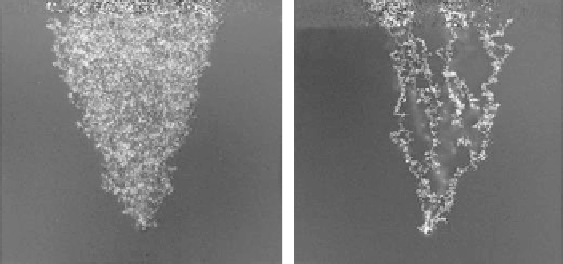Environmental Engineering Reference
In-Depth Information
FIGURE 10.2
Basic gas flow types for bench scale direct gas injection in water saturated porous media. Left:
incoherent bubbly flow in coarse sand (gas clusters), right: coherent channelized gas flow (vis-
cous fingering). (Geistlinger, H. 2010: Model supported high pressure pulsed Gas Injection
(HDI) for in situ Remediation of contaminated Aquifers: Laboratory scale Experiments and
Computer Simulations for Optimization of the Technology. Report Nr. KF0011010SB7-2,
Helmholtz-Centre for Environmental Research UFZ, 63 p. (in German).)
reported in field applications. These clusters are unstable gas-filled bodies
with a magnitude in the order of several pore and solid particle diameters.
Their bulk gas pressure can change due to mass transfer and they cannot
equilibrate the variable capillary forces at their total water interfaces. Gas clus-
ters are moved upward by buoyancy forces and they are laterally spread by
pneumatic cluster displacement when gas is injected. This behavior is defined
as pervasive gas flow. Gas propagation stops when the threshold pressure of
a given sediment or rock layer cannot be overcome. Following the cessation
of propagation, high local gas accumulations and highly coherent gas satura-
tions can be present. This bulk or geological trapping can form reliable gas
storage zones, and groundwater conductivity can be lowered significantly.
When applying the low-pressure NDI method to natural consolidated
sediments, matrix and pore restructuring does not occur. Multiphase flow
characteristics of the sediments remain stable over a large range of total
mechanical stress (Giese et al., 2003). The high-pressure method HDI focuses
pneumatic sediment cracking in the vicinity of the injection point. In addi-
tion, local structure reorganization is needed to generate preferential flow
paths for gas pulse propagation.
10.2.2 Example Test Facilities
A
pore to bench scale
gravimetric-optical measurement system (Figure 10.3)
was developed using coupled cameras to detect overall gas saturations (sta-
tionary camera) and local moving gas bubbles or clusters (dynamic camera)
in a 2D acrylic glass chamber (0.40 m × 0.45 m × 0.01 m). The system allows
for a high resolution in time and space and for simultaneous observations of

Search WWH ::

Custom Search